|
Paintings of Maine
Exhibited July 1 to August 30 2013
Gallery Reception
Friday, July 26th 5-7 PM
"Few if any external influences have made themselves more potently felt in American art than the geographic one exhibited by the coast of Maine. There is something characteristically American typified by these rugged, rocky shores, which has been the inspiration of some of our greatest and most truly national paintings."
- Art Historian, Ralph Carey
Paul Bernard King, N.A. (1867-1947)
Monhegan Island Harbor
25 x 30 Oil (relined),Antique carved frame 31 x 36
Price available upon request
Versatility, artistic maturity and mastery of technique and medium are hallmarks of Paul King's art. His diverse works of portraits, landscapes, rural scenes and illustrations establish his reputation in the first quarter of the century.
From 1906, when his oil painting "Hauling in the Anchor Line" (date and location unknown) captured the Salmagundi Club's top two prizes, King regularly received recognition. His merit was freely acknowledged by his artist peers, as well as by the critics and the public.
King was born in 1867 to a Buffalo, New York goldsmith. Apprenticed there to a lithography firm, he became an accomplished printer. King later studied at the Art Students League of Buffalo and, from 1901 to 1904, at the New York Art Students League with Henry S. Mowbray. While a student, he was an illustrator for "Life" and "Harper's" magazines. From 1905 to 1906, King studied in Holland with Willy Sluiter, Evert Pieters and Bernard Bloomers.
He was a board member of the Philadelphia School of Design for Women, serving as vice president and acting president, from 1908 to 1921. In 1921, he moved from his long-time home in Germantown section of Philadelphia to Stony Brook, Long Island, where he died in 1947.
Memberships: Allied Artists,America Federation of Arts, Artists Aid Society, Artists Fund Society, International Society of Arts and Letters, Pennsylvania Academy of Fine Arts, Philadelphia Art Club, Salmagundi Club
Public Collections:Albright-Knox Gallery, Buffalo; Butler Art Institute, Youngstown, Ohio; National Gallery of Art, Washington, D.C.; Reading Museum, Pennsylvania; Los Angeles Museum; Houston Art Museum; New Pantheon, Nashville, Tennessee. (From "American Art Analog").
Biography from Roughton Galleries,Inc
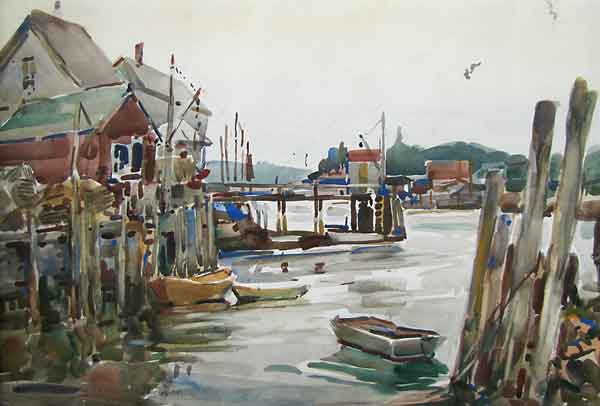
William Lester Stevens (1888-1969)
Harbor at Vinalhaven, Maine
Signed "W. LESTER STEVENS N.A." l.r.
Watercolor 15 x 22 in.
$2400
Born in Rockport, Massachusetts, Stevens spent four years at Boston's Museum of Fine Arts School, where he studied under Edmund Tarbell, among others. Primarily an oil painter, he also used watercolor and acrylics. He is best known for his post-impressionistic landscapes. Throughout the course of his long career, Stevens taught, first in Rockport, then at Boston University (1925-1926) and Princeton (1927-1929), and during the Depression at Grand Manan.
He was a National Academician and a member of the American Watercolor Society; a founding member of the Rockport Art Association; Springfield, MA Art League; Guild of Boston Artists; Gallery on Moors; New Haven Paint and Clay Club, CT; Gloucester Society of Art; North Shore Art Association; Boston Watercolor Club and the New York Watercolor Club. He won art awards at the Corcoran Gallery, Washington, DC; American Watercolor Society; New Haven Paint and Clay Club; Springfield Art League; Salons of America; Washington Watercolor Club; North Shore AA; Rockport AA and more. He painted USPO murals in Dedham and Rockport, MA, the Boston City Hall, the Louisville, KY Art Museum and several schools in Boston. References: Movalli, Charles, American Artist (April 1986); Who’s Who in American Art (1947); Who Was Who in American Art (vol. 3, p. 3171-72).

WILLIAM THON, NA (1906-2000)
MAINE WILDERNESS
36 x 22 Oil on masonite
45 x 31 gilt frame, with linen and gilt liners
Provenance: Midtown Galleries, New York Cit
$3500
William Thon was an American artist noted for highly abstracted landscape paintings. He was born in New York City in 1906, and spent his childhood summers camping on Staten Island. He also developed a great love of travel, and in 1933 made an eight-month voyage to the Cocos Islands in the Pacific. He debuted as a professional artist in 1939 at the Corcoran Gallery Biennial exhibition.
He joined the Navy during World War II, and shortly after the war won the Prix de Rome, a fellowship in Rome to the American Academy, which he later served as trustee. Recognition for him continued with his participation in the 1942 "Artists for Victory" exhibit at the Metropolitan Museum of Art, and in 1944, Midtown Galleries in New York held his first one-person show. This gallery then continued to be his representative throughout his career. He had subsequent solo exhibitions at Smith College Art Museum, Fort Wayne Museum and Farnsworth Museum in Rockland, Maine. He earned an honorary Doctor of Arts from Bates College in Lewiston, Maine in 1957, and was a member of The American Academy and Institute of Arts and Letters, as well as the National Academy of Design.
In 1947, the year-long study at the American Academy proved highly influential on his career, especially with him beginning to paint as much with watercolor as oil. Returning to America, he submitted a watercolor into the 1949 exhibition of the National Academy of Design, and that year was voted into Academy membership. From thereon, he exhibited frequently at the Academy and won prizes including the Benjamin Altman Prize in 1951, 1954, 1961, 1967 and 1969. In 1951, Thon received a grant from the American Academy of Arts and Letters. He returned often to Italy, and in 1955 served in Rome as Artist-in-Residence at the American Academy. However, especially influential was his beloved home countryside at Port Clyde, Maine, where he had made his home just after World War II.
Thon chose to live in the relative isolation of Maine on a peninsula overlooking the sea, a quiet place, especially in winter. He chose the company of sailors, craftsmen, lobstermen, a few fellow artists, and his beloved wife Helen. This area is credited as providing a major breakthrough stylistically because of his discovery of an abandoned quarry near his property. Here he did numerous and increasingly abstract paintings of spidery trees with rectilinear slabs of interspersed granite. While still based in nature, these were by far the most abstract of any of his paintings.
Each season, William Thon would send his paintings off to the prestigious Midtown Galleries in New York City as though sending them on a journey to a strange and distant land. Each bore the imprint of his intense connection to raw and wild things, beautifully contained within the artist's capable and generous temperament. Thon's paintings of Maine had little to do with rural nostalgia or American historical values or the pathos of human relationships. His was a living Maine, a timeless and vital place reflecting his own passion for its rough, beautiful forests, intemperate seas, and the scatter of wooden buildings along its rugged shoreline.
He died at his home in Port Clyde on December 6, 2000 at age 94. He had continued to work after macular degeneration had left him legally blind. From his estate gift of four million dollars, the Portland Museum of Art, Maine, received the biggest cash gift to that time. William Thon was awarded innumerable prizes and is represented in over 60 museum collections including The Metropolitan Museum of Art, The Brooklyn Museum, The Hirshhorn Museum, The Butler Institute of American Art, The Columbus Museum of Art, and in Maine, The Farnsworth Art Museum, The Portland Museum of Art, and The Ogunquit Museum of Art.
Sources:
David Dearinger, Paintings and Sculpture in the Collection of the National Academy of Design, 1826-1925, Volume One.
The New York Times obituary of the artist, December 18, 2000
Wikipedia, http://en.wikipedia.org/wiki/William_Thon
Caldbeck Gallery
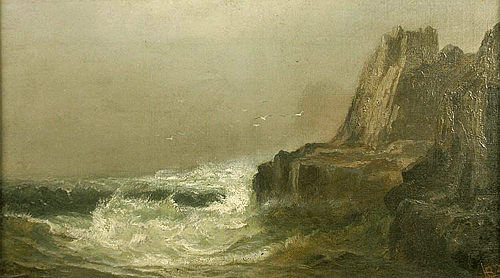
Harrison Bird Brown (1831-1915)
View of Grand Manan
Oil on Canvas 10x18
$5500 Framed
Harrison Bird Brown was born in 1831 in Portland, Maine, and is best known for his White Mountain landscapes and marine paintings of Maine's Casco Bay. By 1860, Brown was being praised as a leading American marine painter. Brown was one of the early artists to paint the coastline of Maine's Monhegan Island, where he depicted the headlands as awesome, mystical forces. Humanity versus nature, and the human relationship to nature, themes prevalent in mid and late-19th century literature and philosophy, figured frequently in his seascapes.
The coast of Maine was a favorite painting venue of Brown's for over thirty years. He depicted the wholesome outdoor environment of the state, with special fondness for the Casco Bay area and Grand Manan, an island off the New Brunswick, Canada coast. Brown also produced two widely distributed illustrations of Crawford Notch for the Maine Central Railroad in 1890.
Harrison Bird Brown exhibited at the National Academy of Design in New York from 1858 to 1860, and at the Boston Athenaeum and Philadelphia Centennial Exposition in 1876. By 1892 he had become the best known native Maine painter of his time, and gained fame for himself and the state with a large canvas in the Maine pavilion of the 1893 World's Colombian Exposition in Chicago. In 1892 he was elected president of the Portland Society of Art.
|
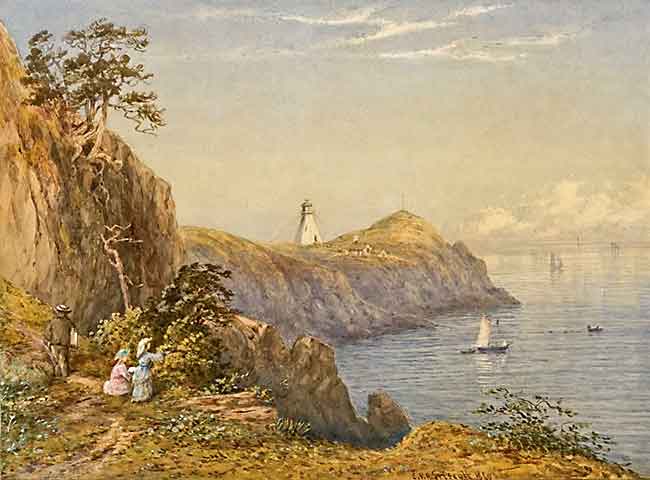
Sparrowhead Light House, Grand Manan
Samuel Peter Rolt Triscott
17.50" x 23.38"
Created: 1890
Framed under glass with mat 28x34
$9000
Samuel Peter Rolt Triscott was born January 4, 1846 in Gosport, England. He was one of five children and had a genteel middle class upbringing. Triscott studied civil engineering. His artistic training in painting was at the Royal Institute of Painters in Water Colors in London under Philip Mitchell.
In 1871 Triscott moved to America and settled in Worcester, Massachusetts where he was a partner in a civil engineering firm. In 1874 he began selling paintings from his office in Worcester. In 1881 Triscott had a one man show at the Boston Art Club. His style of painting with fluent washes of transparent color, though a change from the accepted norm, was well received. Triscott worked as a painting teacher during this time and it is believed his students included Winslow Homer, Sears Gallagher, William J. Bixbee, Woodbridge Gee, Melbourne H. Hardwick, Charles Copeland, William Ladd Taylor, and Robert Henri.
Triscott became quite active in the art world and showed regularly at the Boston Art Club, the American Watercolor Society in New York, The Pennsylvania Academy of Fine Arts and the Gallery of J. Eastman Chase. In 1885, he was one of the founding members of the Boston Society of Water Color Painters.
Triscott began visiting Monhegan Island off the coast of Maine in the early 1890's. The artist purchased a large lot of land which he sold off for cottages in his later years. Every year Triscott increasingly spent more time on the island eventually staying there year round. On April 28, 1894 Triscott was naturalized in Boston. He returned to Monhegan Island and continued to show his work and receive exceptional reviews. S.P. R. Triscott died on April 15, 1925 on Monhegan Island.
Source:
"American Art Review", December 2002
|

Alfred Thompson Bricher (1837-1908)
Figure in a Boat Near Shore
Monogrammed l.r., labels from Barridoff Galleries, Portland,
Watercolor and gouache en grisaille on paper,
sight size 2 3/8 x 6 in. framed
$2800
An Associate of the National Academy, Alfred Thompson Bricher was known especially for his serene, luminist seascapes, reminscent of works by Fitz Hugh Lane and Martin Johnson Heade. Born April 10,1837, Portsmouth, NH, Bricher grew up in Newburyport, MA. Largely self-taught, Bricher studied art at Lowell Institute, Boston in the 1850's. In the 1860s he followed his contemporaries to the White Mountains, and was active in Boston and Newburyport, MA until 1868 when he moved to New York. He executed his best work during the 1870s-80s when he spent many summers painting on the coasts of Massachusetts, Maine (Monhegan Island), and Rhode Island (1871-76), as well on Long Island, especially at Southampton.
Bricher was a significant second-generation Hudson River School landscapist and marine painter who is considered to be the last of the relevant American luminists. He is best known for his marine paintings depicting New England shorelines, in which crashing waves show the dynamic forces of nature.With ease and finesse he captured the natural ambiance around the ocean and its coasts and the artist’s reverence for the presence of what is before him is apparent.
Today A.T. Bricher is considered one of the finest marine painters of his era, and his work is in great demand because each of his canvases and watercolors show resplendently and with confident brushwork how nature looked during the late 19th and early 20th centuries.

SAMUEL PETER R. TRISCOTT (1846-1925)
Ernest Wincapaw's and the Brackett Fish House, Monhegan
Watercolor 17 x 27 in.
$7500
Samuel Peter Rolt Triscott was born January 4, 1846 in Gosport, England. He was one of five children and had a genteel middle class upbringing. Triscott studied civil engineering. His artistic training in painting was at the Royal Institute of Painters in Water Colors in London under Philip Mitchell.
In 1871 Triscott moved to America and settled in Worcester, Massachusetts where he was a partner in a civil engineering firm. In 1874 he began selling paintings from his office in Worcester. In 1881 Triscott had a one man show at the Boston Art Club. His style of painting with fluent washes of transparent color, though a change from the accepted norm, was well received. Triscott worked as a painting teacher during this time and it is believed his students included Winslow Homer, Sears Gallagher, William J. Bixbee, Woodbridge Gee, Melbourne H. Hardwick, Charles Copeland, William Ladd Taylor, and Robert Henri.
Triscott became quite active in the art world and showed regularly at the Boston Art Club, the American Watercolor Society in New York, The Pennsylvania Academy of Fine Arts and the Gallery of J. Eastman Chase. In 1885, he was one of the founding members of the Boston Society of Water Color Painters.
Triscott began visiting Monhegan Island off the coast of Maine in the early 1890's. The artist purchased a large lot of land which he sold off for cottages in his later years. Every year Triscott increasingly spent more time on the island eventually staying there year round. On April 28, 1894 Triscott was naturalized in Boston. He returned to Monhegan Island and continued to show his work and receive exceptional reviews. S.P. R. Triscott died on April 15, 1925 on Monhegan Island.
Source:
"American Art Review", December 2002

Jay Hall Connaway (1893-1970)
Sunset, Monhegan
Oil on board, 24 x 29 in.
$4500
Born in Liberty, Indiana, Jay Hall Connaway was fascinated by coastal life and marine scenery, an attraction that had profound effects on his life and artwork. After periodically studying at the Art Institute of Indianapolis and at the Art Students League with William Merritt Chase, Connaway traveled throughout the United States.ndertake further study in Paris at the Academie Julian and at the Ecole des Beaux-Arts. Encouraged by Robert Macbeth (Macbeth Gal., NYC) and artists Paul Dougherty, Emil Carlsen, and Frederick Waugh, he spent 1922-25 painting at Head Harbor, ME. From 1929-31 he was painting in Brittany and Paris, sponsored by Macbeth and Milch. Returning in the midst of the Depression, he and his family settled at Monhegan Island, ME year-round from 1931 until 1947. when they moved to Dorset and then Pawlet, VT. A popular landscape painter with robust brushwork, he gave lectures and demonstrations around the country. He ran a summer school at Monhegan until 1947, and at Dorset, VT until 1966. His work was featured in an unprecedented 85 one-man shows, evidence of his successful and widely renowned career as a skilled sea painter.
Stefan Alexis Pastuhov
Katahdin Reflections
20 x 30 Oil on Canvas
$3800
Descended from Russian grandparents who fled to America in 1917, Stefan Pastuhov was instantly inspired by his surroundings when he moved to Maine in 1984. In those early years he and Stapleton Kearns painted together almost daily and Pastuhov loved the challenge of painting the changing weather and light, coming and going of the tide, the beautiful red of the blueberry barrens, pristine winter landscapes, and the intemperate seas and rocky coast. He has been especially influenced by painters in the Cape Ann plein air tradition Aldro Hibbard, Emile Gruppe, Paul Strisik, and often paints Maine landscapes with Cape Ann artists like Donald Mosher.
“The fact that I paint outside on location makes each day new. Be it overcast or sunny, snowy or green, ablaze with fall colors or barren of leaves, every location I paint is constantly in change. With this continual flux I am able to paint a number of paintings in each spot, every work attaining an individuality all its own. The intellectual challenge of designing each piece and then undertaking its construction is very meaningful to me as an artist. Capturing the sparkling light of late afternoon or the reflections in a rushing stream will always excite my senses. Although most of my work is done in Maine you will rarely see me anywhere without my paints. Any day that goes by without dipping my brush in paint is a disappointment if not a total loss.”
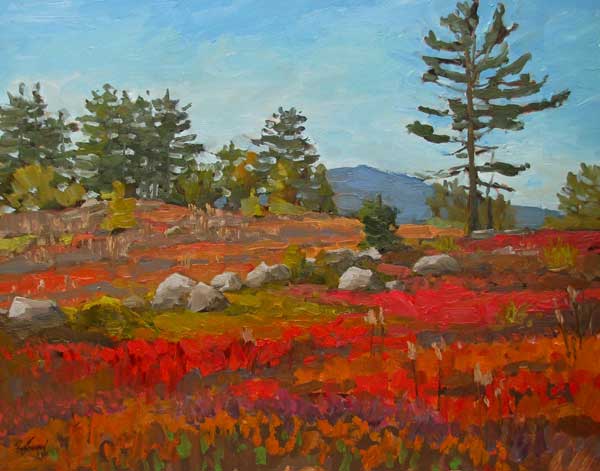
Stefan Alexis Pastuhov
Fall Barrens
16 x20 Oil on Board
$1800
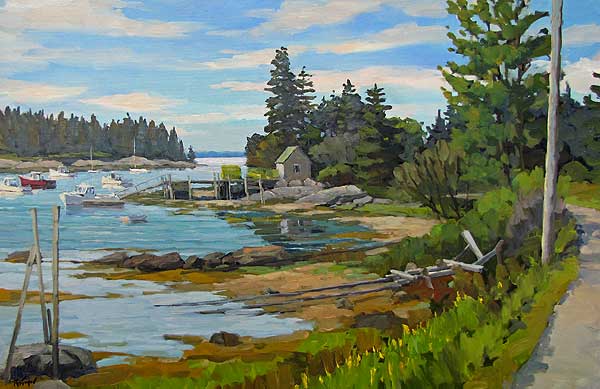
Stefan Alexis Pastuhov
Royce's Dock, Burnt Cove
24 x 36 Oil on Canvas
$4800
Mark is a contemporary realist painter with 30 years experience and a background that includes training in New York at the Arts Students League and the National Academy, as well as several Paris ateliers. He began painting in Maine in the mid 70's with a group of artist friends who came for summers to paint Maine's rocky coast and its many islands. Because he draws his inspiration from those places and things close to him, he eventually relocated to Maine in 1984.
He has shown his work in galleries in New York, California, Florida, North Carolina, and Maine, and was the subject of a feature article in the May, 1995 issue of American Artist Magazine. His work is represented in The Portland Museum Art (The Elizabeth Noyce Collection) and in many private and corporate collections throughout the U.S. and abroad.
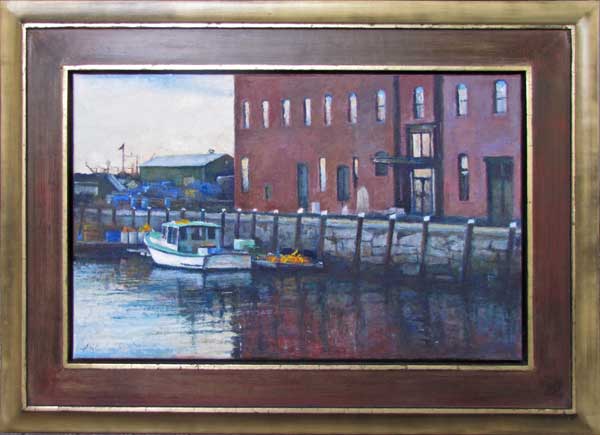
Mark Haltof
Portland Dock
Oil on Canvas 14 x 22 (22 x 30)
$3800

Mark Haltof
Monhegan Surf
Oil on Canvas 18 x 28 (26 x 36)
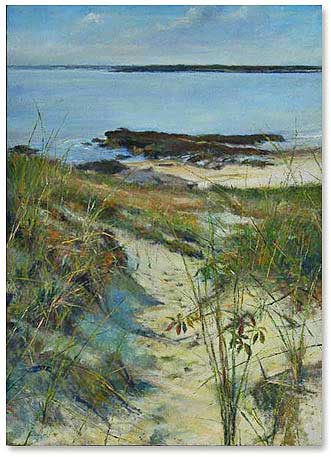
Mark Haltof
Path to the Beach
Oil on Canvas 25 x 18 (33 x 26)
$5000
Neal Hughes
Neal Hughes' paintings are rooted in the American realist tradition as defined by artists such as Winslow Homer, Thomas Eakins and Andrew Wyeth. With a traditional approach to composition and technique his work incorporates contemporary design with a classical sensibility.
Interested in art from an early age, Neal first started painting when he took art lessons in grade school. He went on to graduate from the Philadelphia College of Art (University of the Arts) and his work is included in numerous private and corporate collections. Neal is a signature member of the American Society of Marine Artists, and has won numerous awards, including the Maritime Gallery Yachting Award and an Award of Excellence at the prestigious International Marine Art Exhibition at the Gallery at Mystic Seaport. In addition, he was the grand prize winner of the Utrecht 60th Anniversary Art Competition, winning the top prize out of over 12,000 entries.
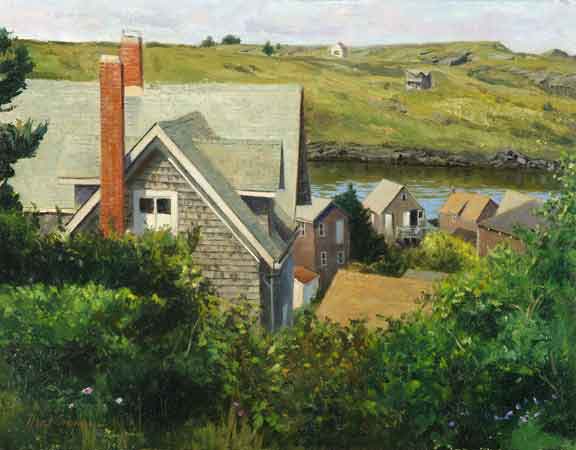
September Sun, Monhegan
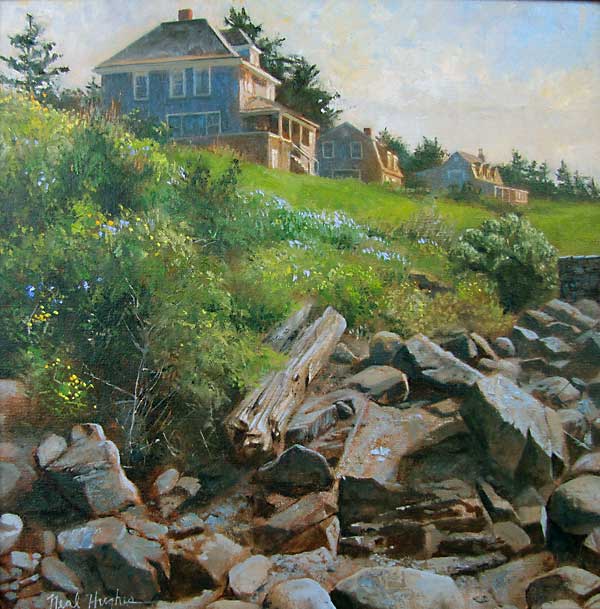
Monhegan Houses
by Neal Hughes
Oil on Canvas 12 x 12
Donald Allen Mosher
Donald Mosher grew up on the North Shore and has lived in Rockport since 1980. A descendant of ship builders from Nova Scotia and farmers from Maine, Don is naturally drawn to the power of the sea and the tranquility of the New England countryside.
His interest in art began after winning his first award at the age of eight, and he has since won over 200 awards for his work. A 1968 graduate of Vesper George School of Art, where he met his wife Christine, Don has been a painting instructor and demonstrator and has been featured in several national publications including Yankee and American Artist Magazine. His paintings hang in the permanent collections of large corporations, institutions, banks, and private homes throughout the United States and abroad including the Peabody Museum, Portland Art museum, and the State House in Boston.
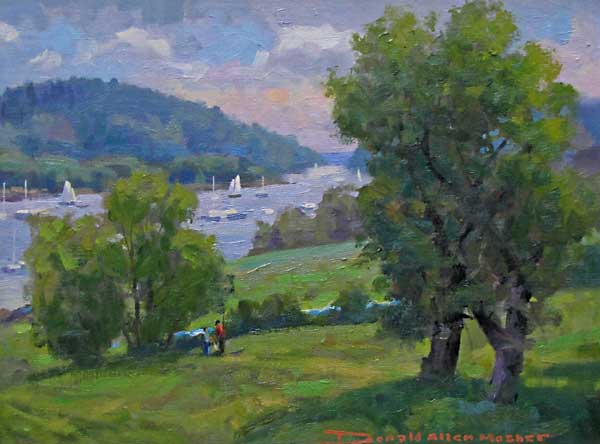
Donald Allen Mosher
Somes Sound
Oil on Canvas 12 x 16
$3200
Caleb Stone studied at the Lyme Academy College of Fine Arts in Old Lyme CT. Since then has been regularly teaching workshops classes , traveling and painting. He works in both watercolors and oils. He has been the recipient of numerous awards, including the John Stobart Fellowship Award , The New England Heritage Award , The Wood Award for Excellence in Watercolor, The Land and Light Gold Medal , Best in Show Manchester by the Sea and most recently achieved Elected Artist at the Lyme Art Association. He grew up in the art colony of Rockport MA. and was exposed to plein air painting by his father Don Stone N.A. at a early age. His attraction to the French and American impressionists and choice of art as a career grew from and was nurtured by this environment. He currently resides on Cape Ann in Massachusetts.

Winter Morning, Monhegan
Caleb Stone
24 x 30 Oil on Canvas
$7000 Framed
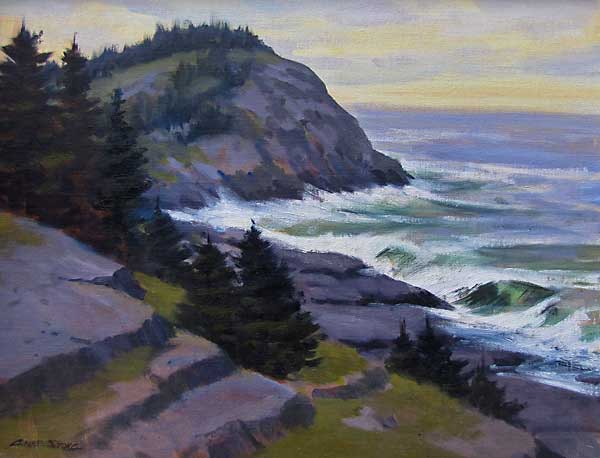
The Headlands, Monhegan
Caleb Stone
16 x 20 Oil on Canvas
$2400 Framed
Swedish born artist, Bertil Whyman, paints coastal Maine with a strong emphasis on color and light. Depicting the atmosphere of the scene is very important to Whyman who attempts "to rediscover who we are by portraying images of where we have been." The old houses, docks and boats, that fill his paintings, represent the care and quality that went into hand crafted items of years ago. Inspired by Vermeer, Manet, Homer and Sargent, Whyman is a self-taught artist whose paintings have been exhibited at galleries throughout Maine, Maryland and Vermont.
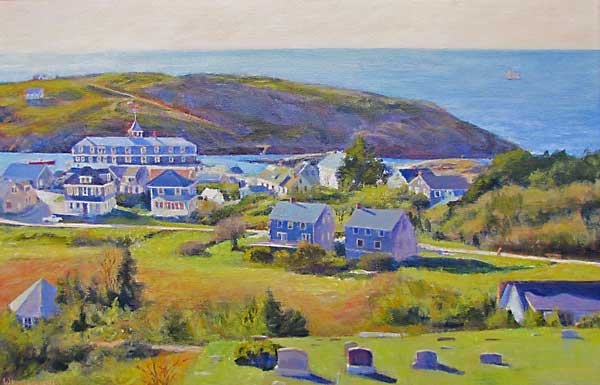
Bertil Whyman
Monhegan & Manana
16 x 24 Oil on Linen
$3200
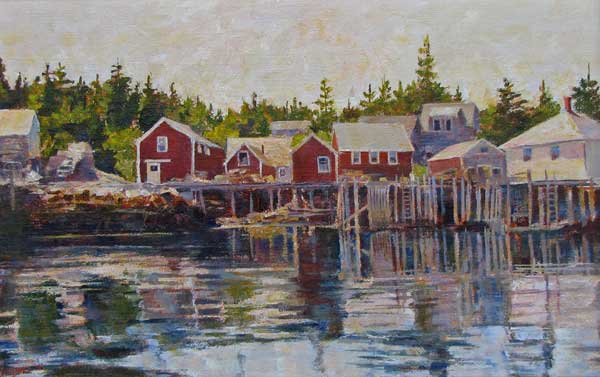
Bertil Whyman
Matinicus Workfront
12 x 18 Oil on Linen
$2000
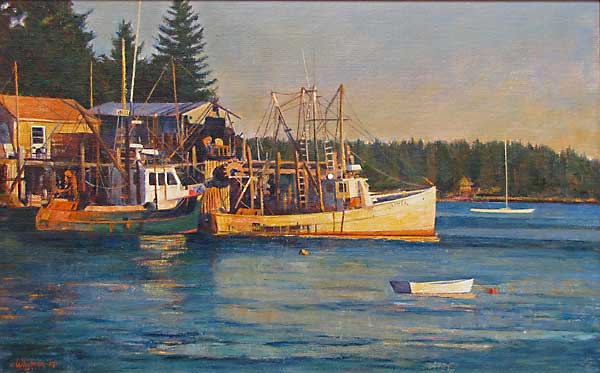
|
Bertil Whyman
Dawn, Port Clyde
14 x 22 Oil on Linen
$2700
Having grown up in a family of oil painters who spent summers in Maine, Karen continues this tradition by returning to Maine every year. She has painted landscapes and coastal scenes en plein air for over 15 years, accumulating knowledge of nature for work in her studio as well. A Connecticut resident, Karen received her formal education at the Lyme Academy of Fine Arts and has participated in workshops with Mike Graves, Chris Magadini, and David Lussier. An Elected Artist member of Lyme Art Association and Kent Art Association, she is also a member of Connecticut Plein Air Painters Society, Deer Isle Artists Association, Housatonic Art League, Society of Creative Artists of Newtown and Washington Art Association.
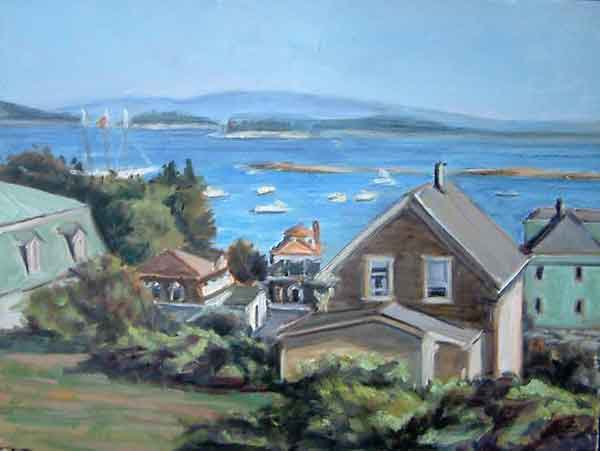
Stonington View
Karen Cashman
9 x 12 Oil on Canvas
$600 Framed
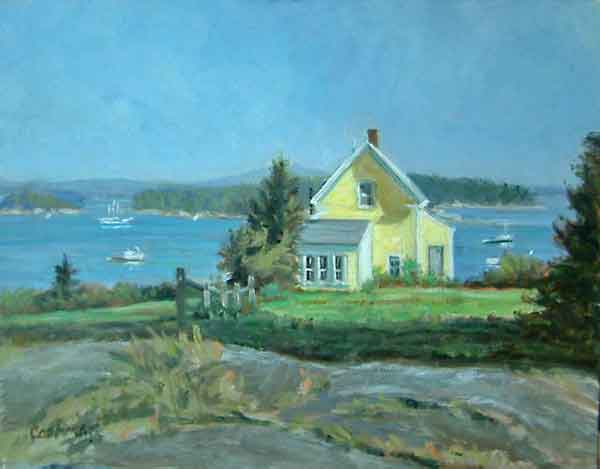
The Yellow House
Karen Cashman
11 x 14 Oil on Canvas
SOLD
Diane Scott was born in Winnipeg , Manitoba , Canada and attended three Schools of Art in Toronto, Canada. She received a Bachelor of Fine Arts degree from Herts College of Art and Design in St. Albans, England, 1985. She also studied for 6 years at North River Arts Society with John Kilroy 1992 -1998 and attended workshops with Lois Griffel, Tom Browning, Kevin MacPherson, Carolyn Anderson, Dan Gerhartz, Scott Burdick, Mark Daily, Don Stone and Randall Sexton.
" My main focus as I mature as an artist has become to find my authentic voice, to embrace it, to protect and defend it, to nurture it, to hold it close to my heart, as I would an imperfect child!"
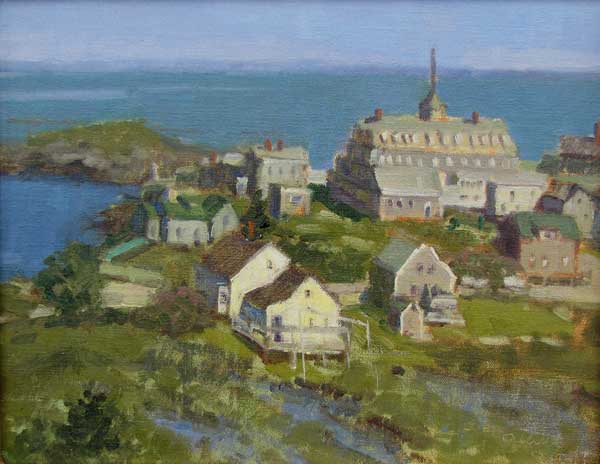
Monhegan Vista
11 x 14 Oil
Diane Scott
$900

Nautical, Castine
11 x 14 Oil
Diane Scott
$900
Dennis Poirier
Dennis Poirier grew up in Gloucester, Massachusetts. He began his formal studies at Butera School of Art in Boston, then returned to Cape Ann to study with John C. Terelak and Ted Goerschner at the newly formed Gloucester Academy of Fine Arts. Later he moved to New York City to study at the Arts Student League winning the Charles J. Romans Memorial Award at his very first national exhibit at the Allied Artists of America Show.
Dennis is a member of many prestigious art associations including the Oil Painters of America, North Shore Arts Association,Rockport Art Association, the Copley Society of Art (a Copley Artist), the Hudson Valley Arts Association, and the Academic Artists Association.
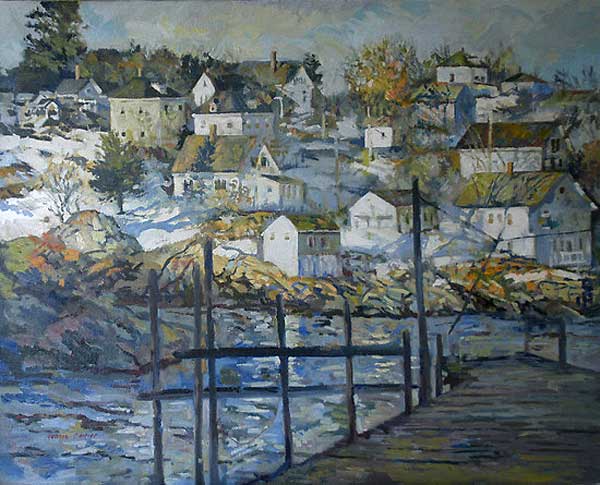
Winter Afternoon, Stonington, Maine
Dennis Poirier
24 x 30 Oil on Canvas
SOLD
Looking Towards Portsmouth
Dennis Poirier
16 x 20 Oil on Canvas
$2200 Framed
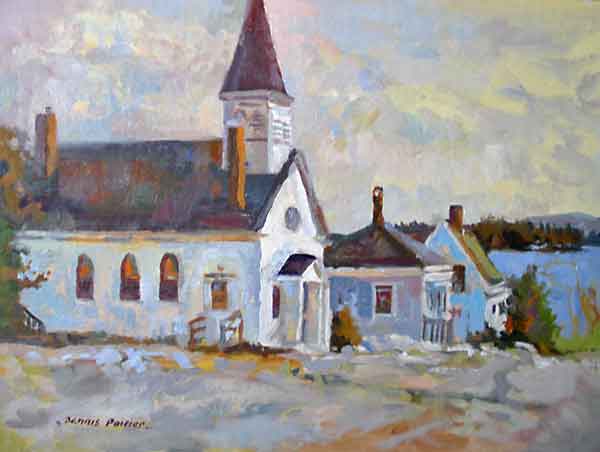
St Mary Star of the Sea, Stonington
Dennis Poirier
12 x 16 Oil on Board
$1250
Kenneth Knowles
Kenneth J. Knowles is a well established talent, known widely throughout New England for his work in landscape impressionism. On a normal day, Knowles spends four to eight hours outside working on the beginning stages of one or two paintings. At any given time, he has as many as 15 projects in progress. He then brings the paintings into his studio for what can be days or months worth of 'finish' before he feels they are complete. "There are several ways to finish a painting, from just a few touches to weeks of adding texture and depth."
Ken was 17 years old when he sought out artists to teach him including well-known Rockport artists T.M. Nicholas and Stapleton Kearns. Later he studied also under John Terelak. He is a member of the Rockport Art Association. His awards include the Silver Brush Award from the American Art Association, the Edward and Elizabeth Schlemm Memorial Award for exceptional landscape in oil, and the Freda Gallery Award. Born in 1968, he is one of the strongest young American landscape painters.

Ken Knowles
Blue Hill Harbor
24 x 30 Oil on Linen
$7500
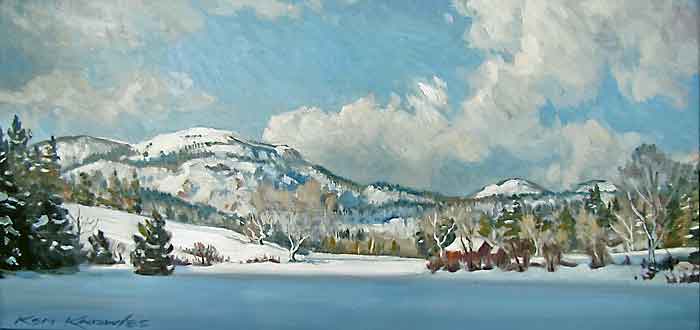
Ken Knowles
Little Long Pond, MDI
12 x 24 Oil on Board
$2950
Marjorie Moskowitz
Marjorie Moskowitz, a native of St. Louis, Mo., was educated at Washington University with degrees in Painting and Drawing. She is represented in Galleries throughout the US and has taught painting, drawing, and art history for eleven years in colleges and universities in the St. Louis and Illinois area, and Otis College of Art, Los Angeles, Ca.
Her move to Ventura County, Ca. in 1998, brought the opportunity for travel to Europe, each year with groups of students, to explore the great art and history of Italy, France, and Spain. The first year, in Italy, she began a new direction: Landscapes. The first was a plein air oil pastel of the view from the Boboli Gardens in Florence. Large paintings and oil pastels followed and included Color Field paintings that have now been exhibited throughout Maine, the Midwest and California.
“These paintings invite the viewer to step into a pliable, welcoming and intense but unknown, mysterious, and complex world. The tension created by these opposing forces is seductive and passionate. The landscape stops the eye; it is prophetic and beautiful yet subject to the constant force of nature. The goal is to see, capture and embody those moments when we see nature for its own particularity and for its own passionate force. The balance between representation and abstraction is nothing if not true to the live process, in which fact and imagination push and pull against each other.”
|

Marjorie Moskowitz
Bluets
Oil on Canvas 16 x 34
$2800 framed
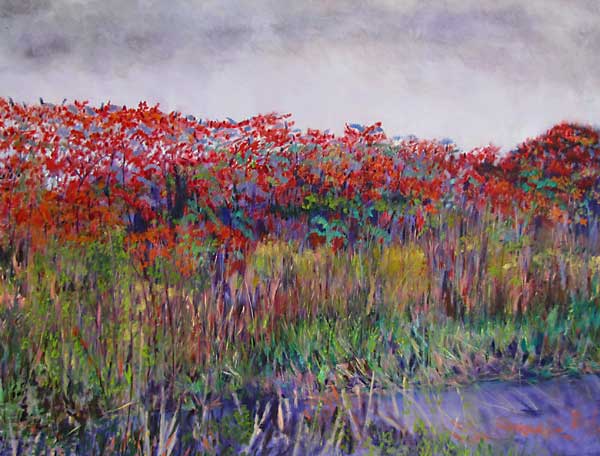
Marjorie Moskowitz
McGee's Field
Oil on Canvas 36 x 48
$6000 framed
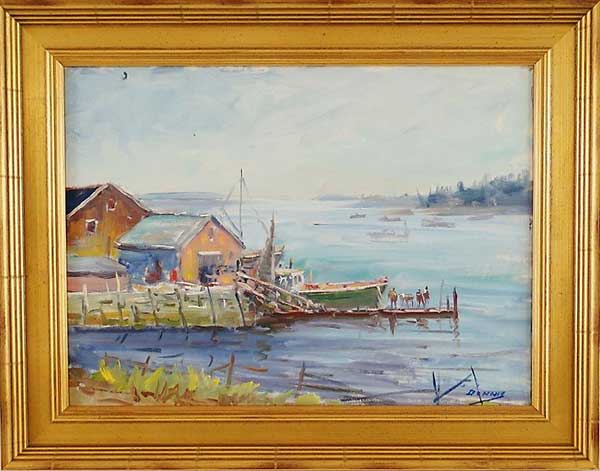
Roger Wilson Dennis (1902-1996)
Deer Isle, Maine
12 x 16 Oil
$1800
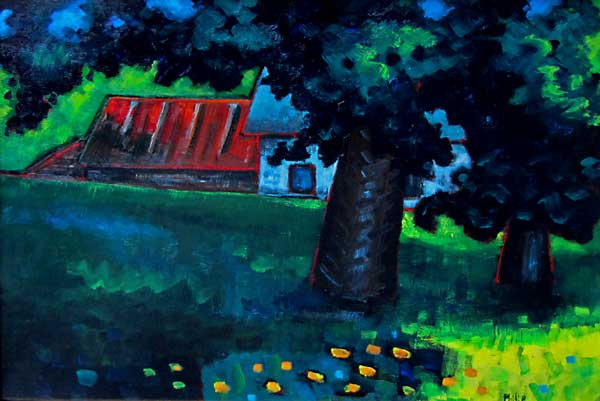
.
Philip Barter
"THE HEEP'S FARM MADRID, MAINE"
Oil on Board 24 x 30
$2700

Bernard Corey (1914-2000)
Coastal Inlet
signed Bernard Corey, l.r., oil on board 10 x 16
Ornate Gold Frame 16 x 22
$3400
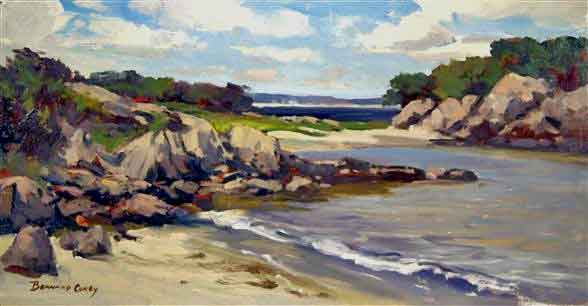
Bernard Corey (1914-2000)
Maine Beach
oil on board 7 1⁄4 x 14
signed Bernard Corey, l.l.
$2800
Bernard Corey is one of New England's most beloved landscape painters of the 20th century. He executed paintings surely en plein aire with accuracy and competence. Memberships included the Rockport Art Association, Salmagundi Club, the Guild of Boston Artists, North Shore Art Association and more. Having won over 100 awards and honors, including awards at the North Shore Art Association, Rockport Art Association, Salmagundi Club, NYC, Hudson Valley Art Association, Providence Water Color Club, Allied Artists of America and many more. He painted almost every day of his life with fellow artists in the fields, along the streams and beaches and in the mountains in and around New England. Although the artist traveled throughout the world, Paris made little impression on him. He was American through-and-through.
Bernard Corey was the "last of the old school" of traditional New England landscape painters. When he died early in 2000, the era when artists painted for ten hours a day, every day with competency came to an end. Corey's carefully painted impressionistic plein aire canvases captured the essence of nature in all four seasons. The Rockport Art Association gave Corey a retrospective exhibition (October-November 2000) saluting the artist's profound understanding of nature and painting.
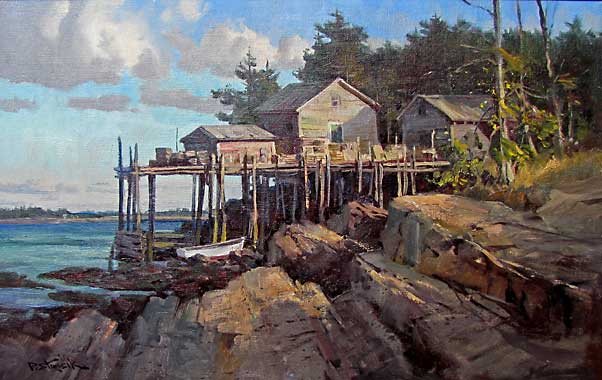
Paul Strisik N.A. (1918-1998)
Maine Coast
Oil on Canvas 16 x 24
Framed 22 x 30, Condition: excellent
$8000
Born in Brooklyn, New York, Paul Strisik became a resident of Rockport, Massachusetts, where he did landscape painting that brought him national recognition. After serving in the Navy during World War II, he studied at the Art Students League in New York City and with Frank Vincent DuMond. In 1953, he moved to Rockport, where he was active in the Art Association and other local civic organizations.
He was a member of the National Academy of Western Art, the American Watercolor Society, and the Oil Painters of America. During his long career, he won 185 awards including 16 gold medals. He and his wife, Nancy, also maintained a home in Santa Fe for 12 years, and in 1996, he was honored as Artist of the Year by the Santa Fe Rotary Club. He was widely respected for his willingness to share his talents with young artists, and taught numerous workshops including at the Scottsdale Artists' School. He wrote several books, his last one being "Capturing the Light in Oils." A reviewer in "Art Talk" quoted him: "God's light on a blade of grass is such a miracle, and so difficult to capture in paint; it is worth a lifetime of trying" (10/98). He died July 22, 1998 at his home in Rockport.
Born in Brooklyn, New York, Paul Strisik became a resident of Rockport, Massachusetts, where he did landscape painting that brought him national recognition. After serving in the Navy during World War II, he studied at the Art Students League in New York City and with Frank Vincent DuMond. In 1953, he moved to Rockport, where he was active in the Art Association and other local civic organizations.
He was a member of the National Academy of Western Art, the American Watercolor Society, and the Oil Painters of America. During his long career, he won 185 awards including 16 gold medals. He and his wife, Nancy, also maintained a home in Santa Fe for 12 years, and in 1996, he was honored as Artist of the Year by the Santa Fe Rotary Club. He was widely respected for his willingness to share his talents with young artists, and taught numerous workshops including at the Scottsdale Artists' School. He wrote several books, his last one being "Capturing the Light in Oils." A reviewer in "Art Talk" quoted him: "God's light on a blade of grass is such a miracle, and so difficult to capture in paint; it is worth a lifetime of trying" (10/98). He died July 22, 1998 at his home in Rockport.
Credit
American Art Review, 10/2001
Judith Curtis, "The Life and Art of Paul Strisik"

Paul Strisik N.A. (1918-1998)
Sparkling Harbor, Maine
Oil on Canvas 10 x 14
Framed 16 x 20, Condition: excellent
$5000
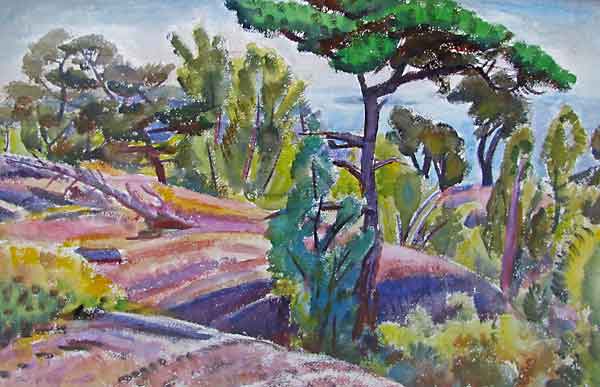
Carl Gordon Cutler (1873-1945)
“Umbrella Pine”
Watercolor on paper, 19.5x 24.5”
Framed 30 x 37
$2400
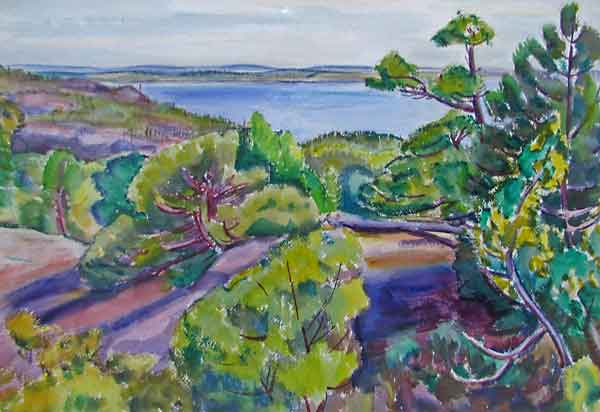
Carl Gordon Cutler (1873-1945)
“View of Eggemoggin Reach”
Watercolor on paper, 17.5x 24.5”
Framed 30 x 37
$2400
Carl Gordon Cutler was born in 1873 in Massachusetts. Though educated in the painting of portraits in oil, his two major artistic passions would become the landscape of Maine and the use of watercolor. His watercolors, influenced by Fauve color and John Marin's forms, were exhibited in Europe and the eastern United States, in Boston; Philadelphia; the Museum of Modern Art, and Whitney Museum of American Art, both in New York City; and, farther west, at the Art Institute of Chicago, Illinois; as well as Paris, France. Cutler had more than a dozen one-man shows in New York City and Boston.
Cutler studied in the late 1890s at the School of the Museum of Fine Arts, Boston, where influence of the old masters on the painting of oil portraits was strong. He also worked at the Academie Julian in Paris. Cutler had some exhibition success there, but it would take several years after his return to America before his mature style would appear. Cutler first painted the Maine coast soon after the Armory Show. By the mid-1920s, he was painting watercolors of the state's landscape exclusivelyviews of Deer Isle, Mount Desert, the Camden Hills and--for thirty summers, Eggemoggin Reach, where Cutler had a cottage. The artist received the plaudits of the critics and acclaim from the public. He spent the last 30 years of his career focusing entirely on painting Maine's Penobscot Bay region.
Carl Cutler was a respected color theorist. In his 1923 book Modern Color, with Stephen C. Pepper, he explained a detailed system involving a scale of 168 colors, telling how to imitate the appearance of natural light through their use. He also discussed emotion as a significant element in artistic creation. In 1994, the Vose Gallery, in Boston, put out a color brochure, Carl Gordon Cutler Along the Maine Coast 1873-1945. Also in the 1990s, the Babcock Gallery, in New York City, published Carl Gordon Cutler, American Modernist Rediscovered, a paperback with forty-four color reproductions and an essay. In 1998, the Portland Museum of Art, in Maine, held an exhibition, "Modern Color": Maine Watercolors by Carl Gordon Cutler, comprised of sixteen out of a total of fifty-nine Cutler watercolors bequeathed a year earlier to the Museum by Mr. and Mrs. James E. Haas. Also in 1998, the College of the Atlantic, Bar Harbor, Maine, exhibited fourteen of Cutler's Maine coastal landscapes painted in the South Brooksville area on the Blue Hill Peninsula.
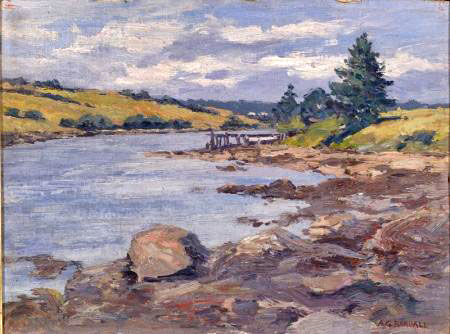
Asa Grant Randall (1869-1948)
"Summer Afternoon at Boothbay"
Oil on canvasboard, 12 x16
$1600
Asa Grant Randall founded the Boothbay Art Colony in Maine in the early 1900's. Randall, from Waterboro, Maine, first visited Boothbay in 1905 and loved the area so much, he was back the following summer, launching what became "The Commonwealth Colony of Art and Industry." Here's how he described the area in a later brochure about his school:
"Boothbay Harbor, the beautiful town by the sea, is the gem of the whole coast. It has been said of this town that nowhere is there a spot with the air more odorous with the scent of the evergreen forest mingled with the clear, bracing salty breath of the ocean. Nowhere can the skies be bluer or the waters clearer. Nowhere is the scenery more beautiful or the surroundings more peaceful."

Stanley Wingate Woodward (American, 1890-1970)
When the Wind Blows West
Oil on Canvas 12 X 16 in.
Stanley Wingate Woodward was a Rockport school painter of marine subjects. He was the author of "Adventures in Marine Painting" and "Marine Painting in Oil and Watercolor" He exhibited widely ( the Penn-sylvania Academy, Corcoran Gallery, National Academy, Boston Museum of Fine Arts, etc.) He was awarded many prizes, National Academy, American Watercolor Society, Baltimore Watercolor Society, Rockport Art Association, North Shore AA, etc. His work is in The Boston Museum, Fort Worth, Univ. of Michigan , Bowdoin College, Amherst College, etc.
|
See the calendar for future exhibitions.
|

|
|

